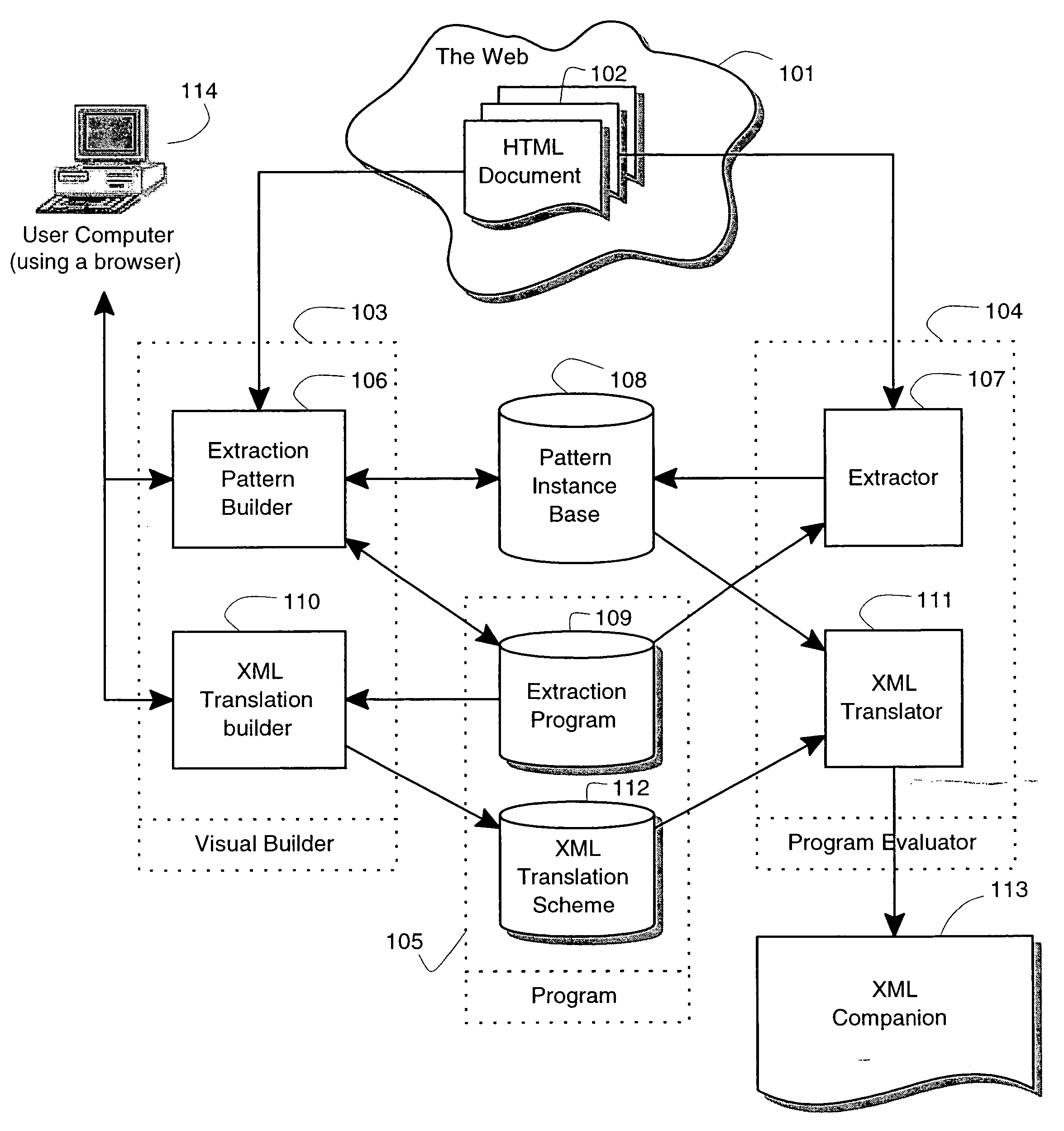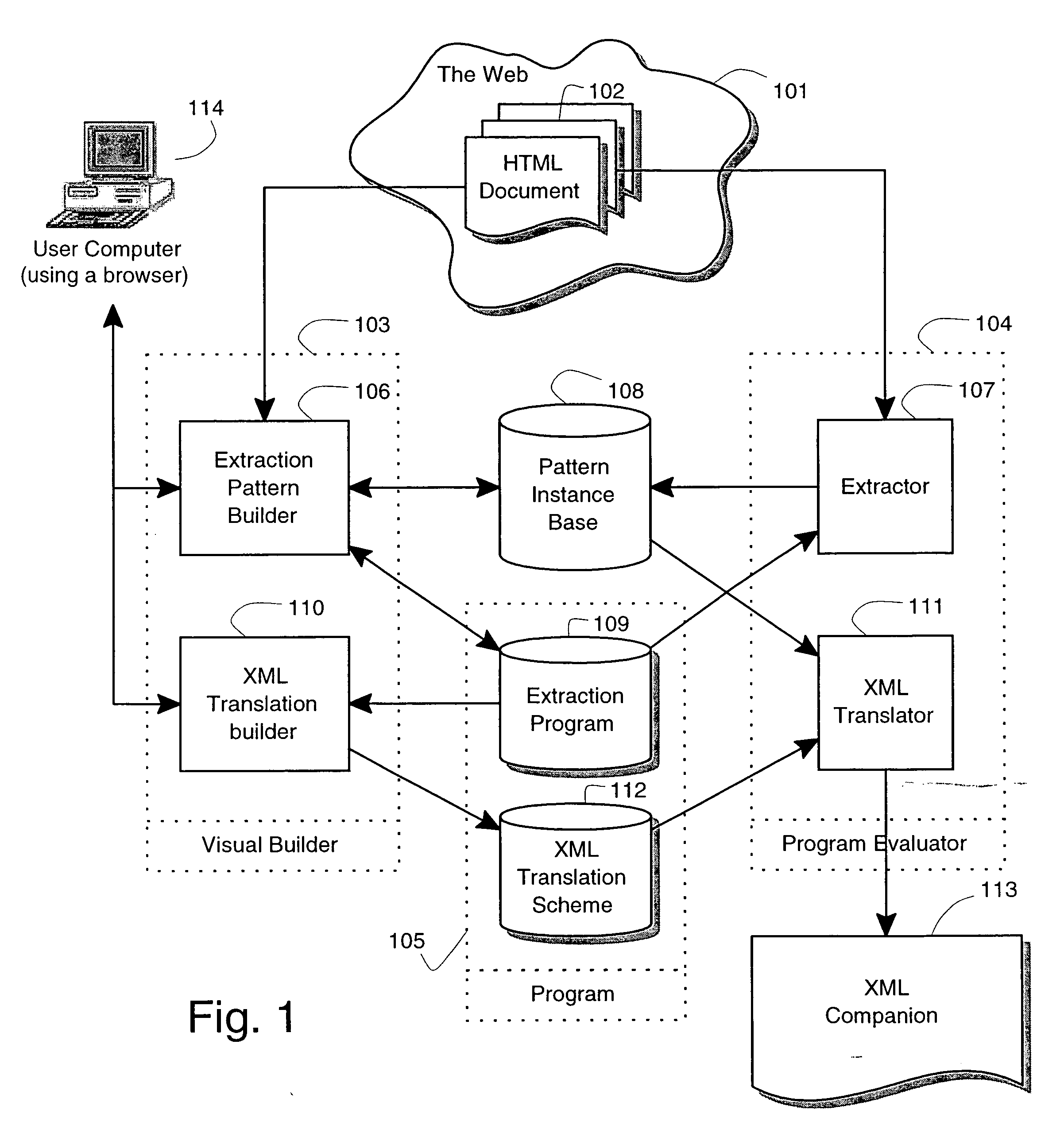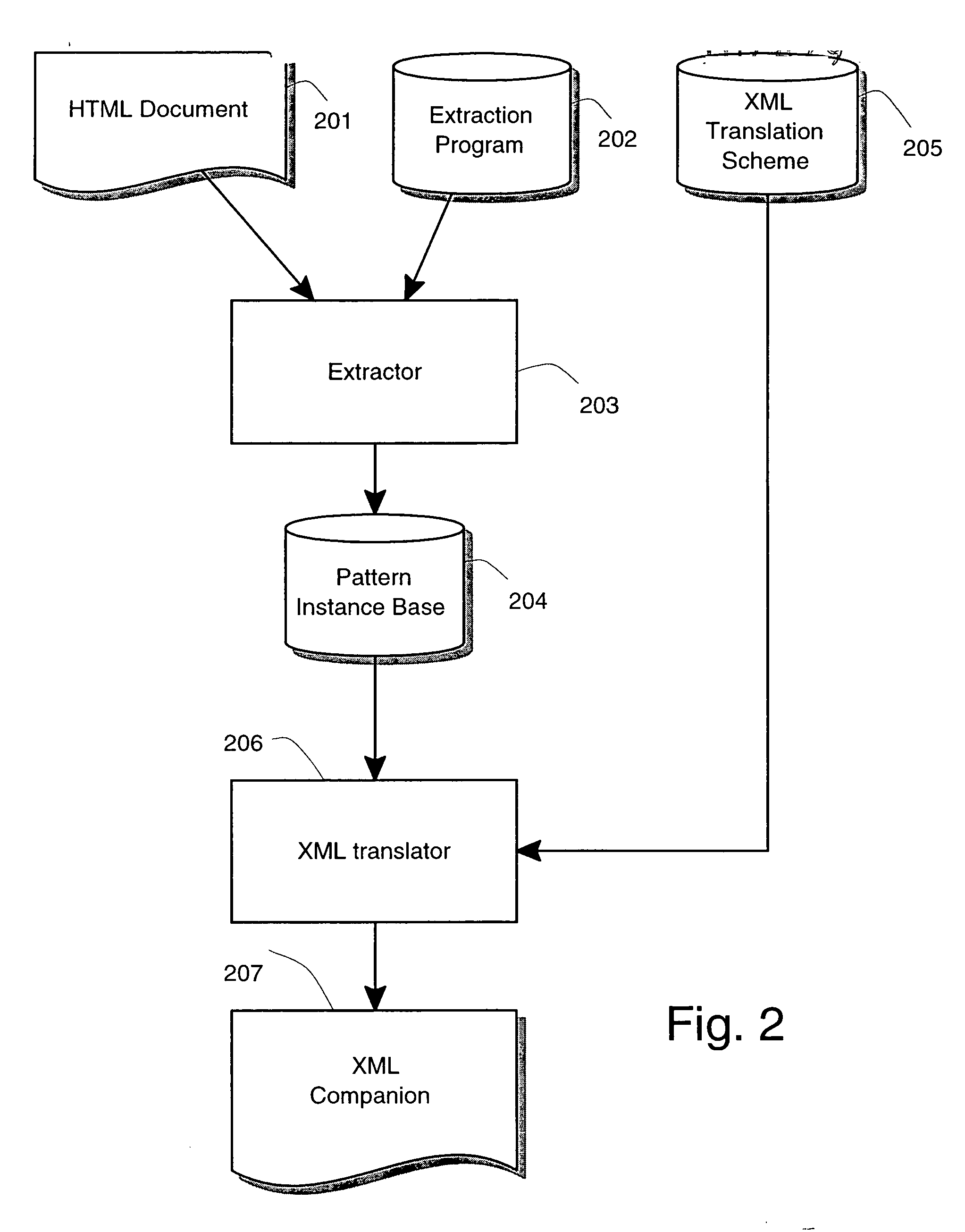This system has almost no proper pattern location and extraction capabilities.
However, there are serious drawbacks of wrapper
programming languages.
In particular, using wrapper
programming languages is very hard for a non-expert, it is tedious, and requires, in addition to
programming skills and expertise in the particular language, the knowledge of markup languages such as HTML.
Testing and debugging hand written wrapper programs is difficult and
time consuming.
Wrapper programming languages are hard to learn for people not skilled in programming and offer no (or at most only very limited) visual support.
This is often much more intricate than what one sees on the screen.
Finally, wrapper programming languages offer no (or no efficient) support for translation into XML.
In summary, wrapper programming languages are not a suitable approach towards our goal of enabling a large number of non-experts to create wrappers for
information extraction and translation into XML.
However, no user-specified information extraction is possible.
Only very few Web change monitoring tools offer additional, somewhat more significant information extraction functions.
In any case, the pattern definition and extraction capabilities of (even advanced) Web change monitoring tools are limited to very simple “flat” patterns, such as paragraphs, portions of text, sections, and numeric values.
The structural information contained in the
parse tree of the document is not sufficiently exploited.
This identification is often not sufficiently robust.
If it changes, the information about the
numeric value location is likely to be lost.
Even such simple requests cannot be expressed by current Web change monitoring tools.
Finally (and not surprisingly), Web change monitoring tools do not have facilities for translating
structured content into XML.
In summary, these tools are far from fulfilling our above described goals and requirements.
Obtaining such samples is in many cases impossible, e.g., because there is only one “current” page available whose content changes slowly.
2000a) is tedious and, moreover, can lead to unrealistic samples in case this task is automated.
Note also that information extraction approaches based on
machine learning have a rather limited expressive power.
In fact, efficient learning algorithms are best suited for flat repetitive patterns and cannot be easily applied to induce complex hierarchical data structures.
For similar reasons, wrappers generated by
machine learning are often not quite robust.
For example, if a wrapper generator is supposed to identify a certain pattern by the property that this pattern occurs immediately behind a date item, and if there are hundred sample pages that unluckily have date items of the same year, e.g. 2001, then the system risks to erroneously induce that the desired pattern must occur after the number 2001 and will not work on pages with dates of the following year.
In fact, the selection of samples and the hand-labeling of a sufficient number of examples and counterexamples in Web pages as well as the correction of certain errors can be rather tedious.
Current systems with visual support are not directly
usable through Web browsers but require the installation of specific
software.
Due to the complexity of the underlying algorithms,
machine learning tools are not quite runtime efficient in case of slightly more complex patterns.
Several wrapper learning tools offer visual support, mainly limited to visual facilities for selecting pattern instances, labeling data, and for displaying induced results.
Unfortunately, NoDoSe does not work that well on HTML files.
Unfortunately, in many cases, the table can become extremely large and confusing.
For example, if NoDoSe is fed with samples consisting of similarly structured eBay pages containing lists of auction items, then the pre-processor transforms these samples into a table with hundreds of columns which is confusing and difficult use.
Most wrapper learning tools apart from NoDoSe do not support translation into XML.
In summary, wrapper generating tools based on
machine learning techniques are not suitable tools in the light of the above-stated requirements.
The user interaction during this structuring phase is limited to correcting certain erroneously recognized tokens that are highlighted on sample documents.
The expressive power of this approach is extremely limited.
There is no possibility of locating desired extraction items by more complex contextual conditions.
Moreover, no user-defined complex patterns can be created that are not already determined by basic formatting issues and
paragraph headings.
Accordingly, the constructed wrappers are not robust, except for sets of input documents having exactly the same formatting structure.
The main drawbacks of this system are: The limited expressive power of its pattern definition mechanism.
First, the system lacks sufficiently powerful semi-automatic generalization mechanisms that allow a user to specify several similar patterns at once while marking only a single pattern of the desired type.
Secondly, the system lacks sufficient visual facilities for imposing inherent (internal) or contextual (external) conditions to an extraction pattern, e.g. “extraction pattern X should appear after a recognized instance of the extraction pattern Y but not before an instance of pattern Z′, and so on.
Thirdly, the division into the two levels of description “region” and “token” and the automatic hierarchical structure extractor severely limit the ways to define extraction patterns.
For example, it is impossible to create disjunctive pattern definitions where a developer specifies a hierarchical pattern in terms of several alternative descriptions.
This is rather tedious in case of complex documents and, in addition, implies that the user must be able to understand HTML code.
Except for certain trivial extraction tasks, the
wizard is not able to generate a full query.
The expressive power of the set of queries that can be visually generated (without hand coding) is extremely limited.
This, in turn, means that, notwithstanding the visual support by the
wizard, the W4F system shares the main aforementioned disadvantages of wrapper programming languages.
Note, however, that HEL is a rather complex language requiring a tricky use of index variables and fork constructs in order to correctly describe hierarchically ordered and / or compound extraction patterns.
The language is hard to learn and hard to use for a person not trained in
computer science.
However, the testing
wizard does not display extracted instances of patterns directly on the browser-displayed input document.
Although this kind of extraction has some advantages, programs are very difficult to update.
One of the major disadvantages of X-Fetch Wrapper is that the
tree structure of H TML is completely neglected.
On such pages, the designer can
label data areas of his choice; however, very often she has to re-edit the program with the DEL Editor.
One of the major drawbacks of the system is that no nested output XML can be generated, but just a flat relational scheme.
Additionally, no flexible contextual conditions are available.
The wisosoft InfoScanner (http: / / www.wisosoft.com) suffers a similar
disadvantage as RoboSuite.
As for the W4F system, the visual interactive part of the extraction-pattern definition process is mainly limited to returning a full tree path which must be manually post-processed.
Again, the expressive power of those XQL or
XPath queries that can be generated by fully interactive actions without manual editing is extremely limited.
Contextual conditions on extraction patterns cannot be easily expressed (if at all).
In summary, existing supervised wrapper generation tools suffer from serious deficiencies.
First, their extraction capability is of limited expressive power (at least, when no editing or programming is involved).
Second, the visual interfaces of these tools require the developer to work on an explicitly represented DOM tree rather than just on the browser-displayed
source document.
This analysis clearly shows that the existing approaches have various drawbacks and do not meet the aforementioned desirable goals and criteria.
For example, the
visual interface of Mind-It is good, but this is to be seen in
close relationship with the limited expressive power of this tool; the visual pattern definition mechanisms of Mind-it cannot be carried over to a tool that allows a developer to specify more complex extraction patterns.
 Login to View More
Login to View More  Login to View More
Login to View More 


